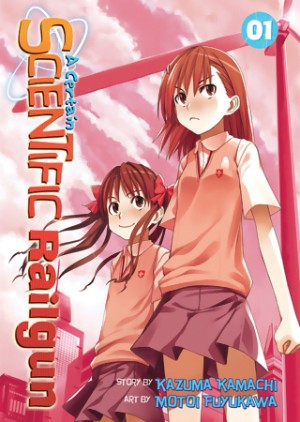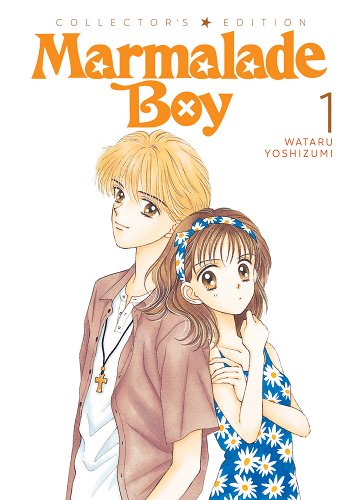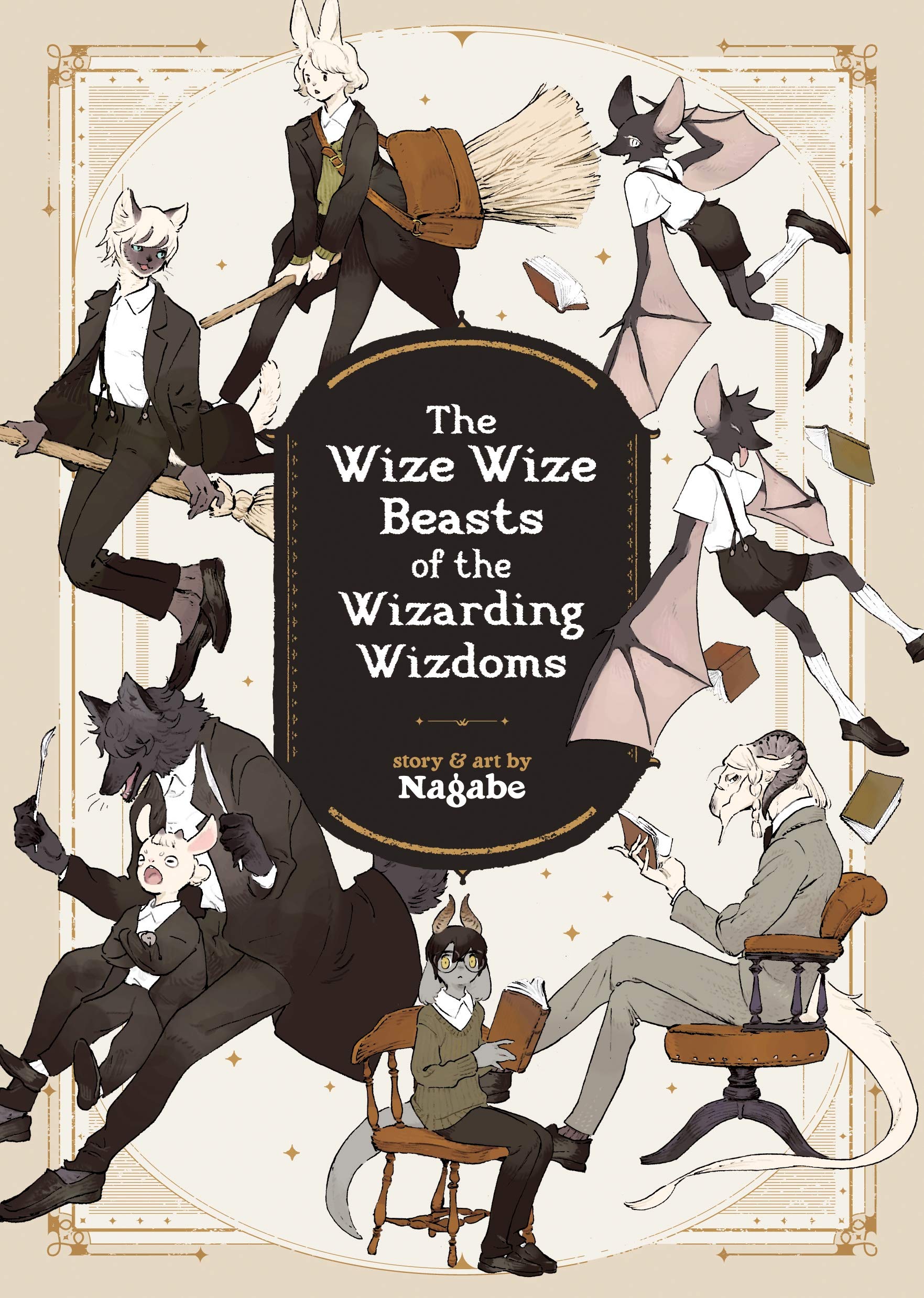Question: what do you get when you cross Sunshine Sketch with X-Men? Answer: A Certain Scientific Railgun, a story about a quartet of schoolgirl psychics who fight crime, go shopping, and eat parfaits. If that combination sounds like the manga equivalent of a peanut butter and tunafish sandwich, it is; the story see-saws between sci-fi pomposity and 4-koma cuteness, never combining these two very different flavors into an appetizing dish.
The story takes place in Academy City, a metropolis whose entire population consists of psychics and psychics-in-training. After a series of bank robberies and bombings, members of Justification, Academy City’s teen police force, make a disturbing discovery: some psychics — or “espers,” in the series’ parlance — are using an illicit drug called Level Upper to enhance their natural ability. (Level Upper is, in essence, steroids for teleporters and mind-readers.) Though the drug grants them tremendous power, that power comes with a terrible price, causing the user to slip into an irreversible coma. The girls must then track the drug to its source before it can spread through Academy City.
As promising as the plot sounds, it often feels like an afterthought, something that happens in between the principal characters’ trips to the mall, the cafe, and the gym. (There’s an entire scene devoted to one character’s efforts to find the perfect pair of pajamas. No, I’m not kidding.) The lead character, Mikoto, is the strongest and best-defined of the bunch; she’s described as a “level-five esper” capable of channeling up to one billion volts of electricity, a skill she gleefully unleashes on robbers, perverts, and her arch-nemesis, a male psychic named Toma Kamijo. Though Mikoto is an unappealing heroine, she’s the only female character who has a real personality; Mikoto is angry, unpredictable, and stubborn, but she’s also very disciplined, cultivating her skills with practice and study. Kuroko, Ruiko, and Kazari, the remaining members of the quartet, are less developed: each girl has one psychic ability that she uses in combat and one adorable tic that she exhibits while hanging out with friends. (Actually, “adorable” is up for debate; grabbing another girl’s breasts seems more predatory than cute.)
Thin as the characterizations may be, A Certain Scientific Railgun faces an even bigger problem: many important plot elements are poorly explained. Not that the series wants for exposition-dense conversation; the opening ten pages are filled with characters narrating Mikoto’s rise from level-zero nobody to level-five bad-ass. But many other details remain unexplored: who is Toma and why does Mikoto detest him? why do so many characters have supernatural abilities? why has the government created an entire city just for young psychics? Perhaps the most egregious example is Mikoto herself; though we learn a lot about her education, the fact that she’s been cloned is glossed over, as if having six genetic doppelgangers was entirely unremarkable.
Given Railgun‘s origins — it’s a side story within A Certain Magical Index, a long-running light novel series — it’s not surprising that so many of these crucial details remain unexamined; the author might reasonably expect Japanese fans to know the Magical Index universe well enough to jump into Railgun with a minimum of exposition. For a newcomer, however, the experience is frustrating; uninteresting plot points are explored in excruciating detail, while many of the things that seem more fundamental to the story (e.g. the characters’ psychic abilities) are barely addressed at all.
The final chapter suggests that future installments may feature more scenes of crime-solving and fewer scenes of tweenage girls showering, eating desserts, and horsing around. An honest-to-goodness mystery would go a long way towards giving the story some dramatic shape; right now, A Certain Scientific Railgun feels as aimless and airy as a volume of Sunshine Sketch, even if Mikoto and friends have cooler talents than the Sunshine girls.
Review copy provided by Seven Seas. Volume one will be released on June 30, 2011.
A CERTAIN SCIENTIFIC RAILGUN, VOL. 1 • STORY BY KAZUMA KAMACHI, ART BY MOTIO FUYUKAWA • SEVEN SEAS • 192 pp. • RATING: TEEN (13+)




Logan says:
I was worried this series might rely a little too much on previous knowledge of the series but I’m still disappointed to see my fears confirmed as I was hoping this series would have enough success to warrant licensing some of the rest of this franchise. As someone who’s seen all the A Certain X Y anime and adores Mikoto I’m looking forward to it still, but it’s interesting to read an outsiders perspective on it. While I’ve always preferred the Railgun sidestory to it’s parent story, the anime was never rich enough in details about the world of Magical Index to function on its own, so if the manga continues to follow that example it could definitely alienate anyone who hasn’t seen the anime (which is anyone who doesn’t watch fansubs, since Funimation is yet to release any of Index).
One of my favorite arcs of the anime was one that dealt with the whole issue of her clones, so I’m hoping they’ll go into that more in the later volumes. It’s a bit too big of a mystery to just gloss over without any backstory or depth.
Unfortunately though, even if the plot starts to pick up, your main issue of the series having trivial slice of life elements is likely to always remain to some extent. At it’s core Railgun has always seemed to me like a series the exists to pander to fans of Mikoto (or tsunderes in general), so that cutesy slice-of-life element will probably always remain to some extent (to the detriment of the potentially interesting plot). I’m hoping volume 2 will prove me wrong about this, but I’m not holding my breath for it.
Katherine Dacey says:
Hi, Logan! It’s just as useful for me to hear from readers who know more about the Railgun/Magic Index universe than I do, as this series is really being licensed for you. I’m glad to know I wasn’t the only one who felt some of the more important aspects of the story were a little undercooked; if the characters didn’t have psychic abilities, there’s nothing in volume one that would make me realize that magic was, in fact, fundamental to Railgun.
I’m also not a big fan of the kind of moe antics that pop up again and again in the story; about the third time Kuroko grabbed Mikoto, or Ruiko exposed Kazari’s panties, I started to check out. I must have had really boring friends when I was a girl, because I don’t ever remember my friends ever doing anything that aggressive!
Thanks for the additional background on the series!
Abe says:
To clarify, the anime of railgun was based off this manga. While the anime skips the arc with misaka and her clones (as it was covered in the original), the manga goes into it in extended detail. If I remember correctly, the manga just finished this arc.
It’ll be interesting to see what the author does with this series as misaka becomes an increasingly important character in the light novels.
But I agree with the previous assessments of this manga. While the experience is mildly entertaining as a standalone, it becomes exponentially more enjoyable if the reader has watched or read the origin story.
Something I would like to know is how the paper quality and translation is for this manga. I find it very interesting to see translated interpretations, but have been continually disappointed with the paper quality of the manga translated. So while it is fun to compare the two versions, I would like to save my money if the quality of the product does not match what I currently own.
Katherine Dacey says:
If the Railgun manga explores the issues of Mikoto’s clones, it’s in a later volume; they’re mentioned in passing in volume one, but no one explains their significance. For someone like me, who’s coming cold to the material, my first thought was, “Wait, she’s been cloned? Isn’t that a pretty important detail to be glossing over?” I’m sure it’s a lot less confusing for folks who’ve read the Magical Index light novels or seen the anime.
As for the paper stock, I wish I could be of more help. Seven Seas sends reviewers electronic galleys, so I read the entire book on my computer; I haven’t yet seen a physical copy. Maybe another reader could help you out: folks, who has experience with a recent Seven Seas manga? How’s the paper quality?
bunny says:
It does. The whole “Sisters” thing and Accelerator, etc.
(Note, I read the Japanese ones, it’s a side effect of where I live.)
N says:
I hate how a manga with a brilliant title will so often be a terrible moe-whatsit. The big problem is that the creator(s) seem to put most their energy into the title. Then again, in many cases that’s all hardcore otaku need to think the series is “offbeat” and “original.”
Katherine Dacey says:
I think it’s safe to say that you’re right about Railgun: more thought went into the title than into the plot details!
Aaron says:
I read it and honestlly I can’t wait till it get’s in to the later arcs especially when Accelertor get’s introduced becuese his whole trun from amoral psychopath to mildlly less psychotic anti hero gives a whole lot more depth to the story. But right now it’s like bad slice of life and Rukio just creeped me out. I checked out right around the first “skinship grope” but I found Mikoto an intresting charcter but saddly underdevloped.
Jade Harris says:
A hunt for the perfect pajamas sounds like something awesome to do in real life, but not so much to read about in and of itself. Now, seeing how super-powered E.S.P.ers shop for their perfect pajamas could be a very entertaining take on common pajama-shopping tropes, but when it turns out to be just some bland imagining of how it’s really done, not so much.
That’s what I hate about this kind of moe story. I believe that fantasy stories are based on the world around us as extreme metaphorical observation. This sort of story sees fantasy purely as escapism and attempts to make that world more ‘realistic’ by making the fantastical elements bland, like real life, but still fantastical enough for fan service and eternal tweens to exist. It’s not an observation of reality, not even satire or a take on the media that inspired it, it’s just a big wad of literary gymnastics performed so the reader can pretend girls actually act like that and still be able to defend it from criticism.
Katherine Dacey says:
You’ve hit the nail on the head: why go to all the trouble of giving people special powers and inventing an alternative universe if all your characters are going to do is go to the mall? Jeez, I could do that on my own time and get more out of the experience!
Jade Harris says:
Actually, I’m a big fan of seeing super-people go to the mall, but I still want them to have a mall experience appropriate to or contrasting their super-powered lifestyle.
What I see here that I was getting at is how the fantasy elements just seem like a thin justification for the true purpose of fantasizing about what real girls supposedly act like. You get this little society where girls are constantly trying on pajamas and groping each other and flipping skirts and the reader can bathe in this world of ‘real’ girl behaviour, but then that thin veneer of fantasy elements allows them to defend how ridiculous it all is by saying it’s just a fantasy story.
I don’t mind a fantasy story with a bunch of cheesecake thrown in, but this one boils down to a bunch of literary gymnastics to justify people holding misconceptions about real girls. That’s the real dark side of moe.
Silarial says:
Being a fan of the Index/Railgun franchise, I was happy when the Railgun manga was licensed. However, I always believed it was strange that the side story made it to America before the main story. I couldn’t see how Railgun would be accessible to new readers since the manga was made to pander to readers who were already familiar with Index’s world and characters. If I just picked up Railgun out of curiosity and noticed the random inclusion of the Toma Kamijo character, for instance, I would believe it was poor writing on the part of the author. I’m sure the author had no explanation for Toma’s appearance since he was already expecting the reader to know that this character was the main protagonist of Index and required no further explanation. Railgun was made to be a fun side story that gave greater characterization to some of the minor characters of Index, so it lacks some of the back story and world building from Index to prevent rehash of familiar material. Railgun was given the tough task of selling itself on side story material alone, which might not have been enough. Waiting till the Index franchise made it to America (in the form of the anime or the light novels) would have probably been a safer way of establishing a stronger audience for Railgun.
Katherine Dacey says:
Railgun was made to be a fun side story that gave greater characterization to some of the minor characters of Index…
It’s too bad, then, that Seven Seas licensed the side story before the main series; it would be like licensing The Melancholy of Haruhi Suzumiya-chan before the novels or the manga!
I just took a peek at the Wikipedia entry on Certain Magical Index, thinking that series length might have led Seven Seas to choose Railgun as their port of entry into the Index universe. It turns out that both manga are about 6-7 volumes right now, and are still running in their respective magazines. So there goes my theory! Do you know anything about the anime’s history here in the US: have both series been licensed for the US, or has only one?
Ktach says:
The answer to your question can be answered by this exchange on the sevens seas forums:
(Para phrased)
“What titles should we license?”
“How about a certain magical index and a certain scientific railgun, they have anime series coming up too.”
“Index is by square-enix so its unlikely we will be able to get it, yen press has a exclusive deal with square.”
“But railgun runs in dengeki daioh”
*Several months pass*
“Ok, we have a new license to announce.”
Katherine Dacey says:
Thanks—that makes sense, given that Seven Seas has licensed other Dengeki Daioh properties.